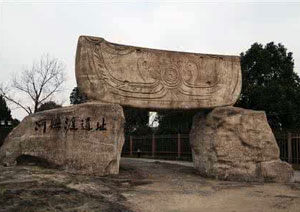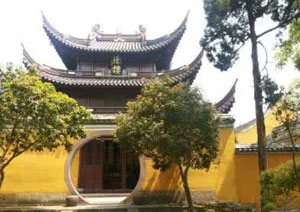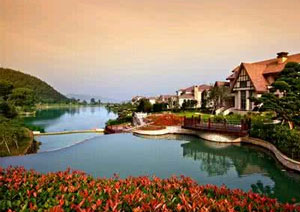Hemudu Culture Relics
 Hemudu Culture Relics, named after a nearby village of Yuyao City, is located 25 kilometers west of Ningbo. Surrounded by Siming Mountain on the south, Yuyao Plain on the north and Menqian Mountain on the east, it was formerly named Huangmudu that dates back to the Neolithic Age. Hemudu Cultural Relics was uncovered in 1973 and a total of 2,800 m2 has been unearthed through two phases of excavation efforts. With a history of more than 6,900 years, Hemudu Cultural Relics has unveiled a well of unique and time-honored culture, and was hence called the "Hemudu Culture" in the academic circles. Hemudu Cultural Relics cover an area of 40,000 m2 and is made up of four cultural strata that are inherently correlated and lay one upon another.
Hemudu Culture Relics, named after a nearby village of Yuyao City, is located 25 kilometers west of Ningbo. Surrounded by Siming Mountain on the south, Yuyao Plain on the north and Menqian Mountain on the east, it was formerly named Huangmudu that dates back to the Neolithic Age. Hemudu Cultural Relics was uncovered in 1973 and a total of 2,800 m2 has been unearthed through two phases of excavation efforts. With a history of more than 6,900 years, Hemudu Cultural Relics has unveiled a well of unique and time-honored culture, and was hence called the "Hemudu Culture" in the academic circles. Hemudu Cultural Relics cover an area of 40,000 m2 and is made up of four cultural strata that are inherently correlated and lay one upon another.
Asoka Temple
 Sitting at the piedmont of Yuwang and Mount Mao, Yin County, Asoka Temple is one of the Five Mountains of Buddhism's Chan Sect (Zen) in China. As a famous temple of Chan sect of Buddhism in China, Asoka Temple has an important role in the history of Buddhism in China and in the history of Sino-Japanese cultural exchanges. Especially, the Real Body Relic of Sakyamuni, treasure of the Buddha Kingdom, enshrined in the temple. As a temple that keeps the exquisite sputa with the Sykyamuni's sarira and, the temple enjoys a very high reputation among Buddhist believers both at home and abroad. Formerly Asoka Temple located at the foot of Yuji Mountain, and it was built in 282 the Western Jin Dynasty (265-316), and then moved to where it stands now.
Sitting at the piedmont of Yuwang and Mount Mao, Yin County, Asoka Temple is one of the Five Mountains of Buddhism's Chan Sect (Zen) in China. As a famous temple of Chan sect of Buddhism in China, Asoka Temple has an important role in the history of Buddhism in China and in the history of Sino-Japanese cultural exchanges. Especially, the Real Body Relic of Sakyamuni, treasure of the Buddha Kingdom, enshrined in the temple. As a temple that keeps the exquisite sputa with the Sykyamuni's sarira and, the temple enjoys a very high reputation among Buddhist believers both at home and abroad. Formerly Asoka Temple located at the foot of Yuji Mountain, and it was built in 282 the Western Jin Dynasty (265-316), and then moved to where it stands now.
Baoguo Temple
 Baoguo Temple, situated in the Valley of Lingshan Mountains, 15 kilometers to the north of Ningbo, is the oldest and most completely preserved wooden Buddhist building with a unique design and impressive vigor, dated to the Northern Song Dynasty in South China with over 970 years of age. Its roof was renovated in Kanxi 23rd Year and took the shape of gable and hip roof. Listed among the wonders of Chinese architectural civilization, the ancient palace is now as impressive as it used to be, and assumes high historic, artistic and scientific values. Its main characteristics include: the width of the palace (13.38m) is greater than its length (11.83m), in the form of a vertical rectangle; three perforated caissons are adroitly designed in its front hall ceiling; the intricate Dougong structure; four coated arrays columns with obvious flank feet at their bodies; a peculiar moon beam style with two folding shoulders.
Baoguo Temple, situated in the Valley of Lingshan Mountains, 15 kilometers to the north of Ningbo, is the oldest and most completely preserved wooden Buddhist building with a unique design and impressive vigor, dated to the Northern Song Dynasty in South China with over 970 years of age. Its roof was renovated in Kanxi 23rd Year and took the shape of gable and hip roof. Listed among the wonders of Chinese architectural civilization, the ancient palace is now as impressive as it used to be, and assumes high historic, artistic and scientific values. Its main characteristics include: the width of the palace (13.38m) is greater than its length (11.83m), in the form of a vertical rectangle; three perforated caissons are adroitly designed in its front hall ceiling; the intricate Dougong structure; four coated arrays columns with obvious flank feet at their bodies; a peculiar moon beam style with two folding shoulders.
Dongqian Lake Scenic Site
 Dongqian Lake has a vast body of water and a winding waterfront. It is China's first fresh-water fishing farm with abundant resources. It is surrounded with so many mountains in all directions that the mountains and the lake crisscross in turn forming a copy of beautiful mountain and water Chinese drawing. Being a provincial scenic spot as well as a comprehensive tourist resort for travel, entertainment and vacation, the Dongqian Lake Scenic Site consists of three lakes, namely, the Grain Lake, South Lake and North Lake. There are also large amounts of inscribed stones for the tombs built in the Southern Song Dynasty around the lake. The finely carved stone and the gracefully designed pattern on the stone fill in the gaps of both the sculpture and the art of the Southern Song Dynasty in Chinese history of sculpture and arts.
Dongqian Lake has a vast body of water and a winding waterfront. It is China's first fresh-water fishing farm with abundant resources. It is surrounded with so many mountains in all directions that the mountains and the lake crisscross in turn forming a copy of beautiful mountain and water Chinese drawing. Being a provincial scenic spot as well as a comprehensive tourist resort for travel, entertainment and vacation, the Dongqian Lake Scenic Site consists of three lakes, namely, the Grain Lake, South Lake and North Lake. There are also large amounts of inscribed stones for the tombs built in the Southern Song Dynasty around the lake. The finely carved stone and the gracefully designed pattern on the stone fill in the gaps of both the sculpture and the art of the Southern Song Dynasty in Chinese history of sculpture and arts.
| Ningbo Attractions List | |

